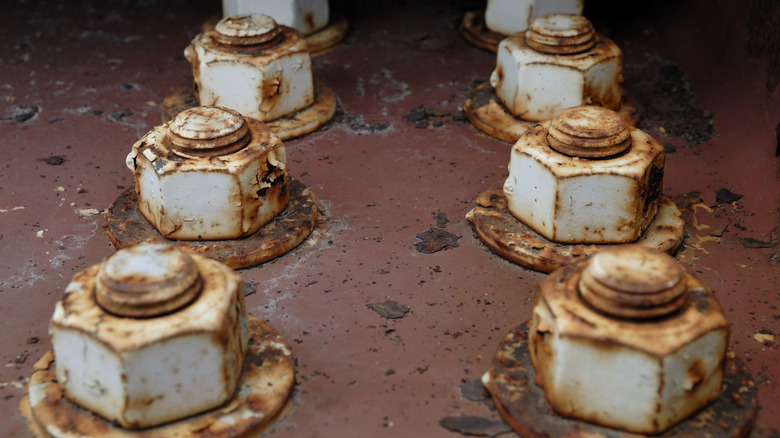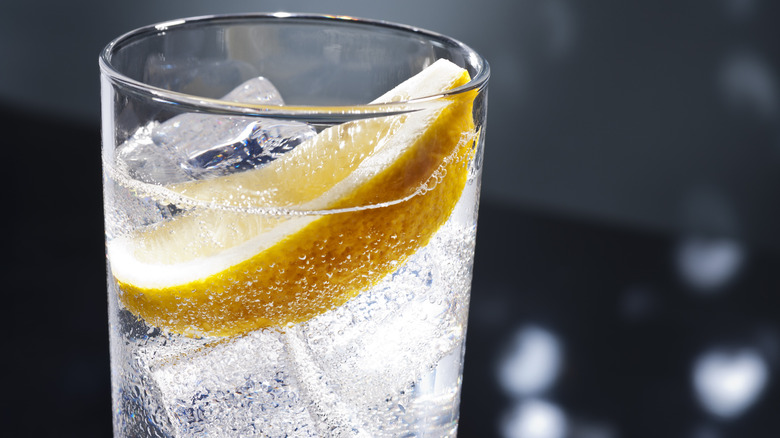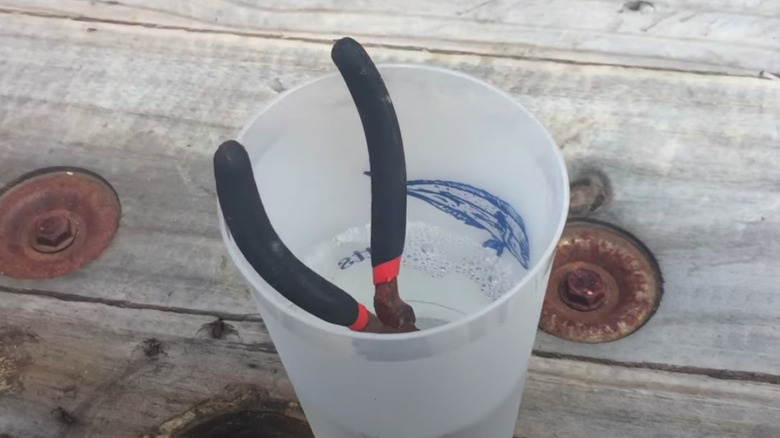Grab This Common Bar Ingredient To Eliminate Rust
Around your home or apartment, from time to time, you may encounter a rusty item. Perhaps it's the nut or bolt on a drying rack or a screw holding together an older appliance. Needless to say, at some point, you'll likely need to reach for a handy tool in order to help remove rust stains and restore the metallic gleam on your item. While there are many commercial rust removers that do work well, some of them are full of chemicals, which can be dangerous to you and your pets. What's more, you probably don't have these fancy rust removers hanging around the house when you're in a pinch. Fortunately, you can head over to your bar cart, because you likely already have some club soda lying around that will be just the trick you need to break down any stubborn rust.
Club soda is a great choice as an alternative to chemical rust removers or even WD-40 because of its simple composition. Club soda is comprised of carbonated water and naturally occurring minerals that happen to be mostly acidic in nature, making it able to penetrate through rust deposits on household items. These nontoxic minerals pose no threat to you, your family, or the environment, which makes choosing club soda a great idea when you're in need of a quick solution. So, put down your vodka, and head over to your rusted items with your sparkling bottle of club soda to get started.
Why club soda dissolves rust
Rust is an oxidized form of iron that occurs when iron is exposed to oxygen and moisture. As iron oxidizes, it forms rust, which appears as a reddish-brown coating on the metal surface. Club soda can help break down this rust due to its acidic and abrasive properties. The main ingredient in club soda is carbonated water, which contains carbon dioxide gas. This carbon dioxide reacts with water to form carbonic acid, giving club soda a slightly acidic pH. While not extremely acidic, it is enough to react with the iron oxide in rust. The carbonic acid helps dissolve and loosen the bonds in the rust molecules. In addition, the bubbles in club soda provide an abrasive force as they burst on the rusted surface. This scrubbing action works with the carbonic acid to help break apart and dissolve rust deposits.
The sodium bicarbonate, commonly known as baking soda, and sodium citrate found in club soda may also assist in rust removal. Sodium bicarbonate is an alkaline salt and can help neutralize and wash away traces of acidity from the dissolved rust. Together, the carbonated water and sodium bicarbonate in club soda provide chemical and physical actions to effectively break down and dissolve rust from iron surfaces. A club soda soak or scrub can often remove light to moderate rust without the need for harsh chemicals.
How to remove rust with club soda
Using club soda is a great way to help break down mild rust deposits on your household items. One easy method to apply club soda is soaking the item to loosen rust buildup. Of course, this method should not be used for electronic items, as it may compromise electrical components. To start, fill a container with club soda and submerge the rusted item. Let it soak for a few hours. The longer it soaks, the more the club soda can break down the rust. When time is up, remove the item and easily clean rust off the metal with a cloth or brush. The soak allows the club soda to fully penetrate and rust to weaken before washing and rinsing.
For more concentrated rust, try scrubbing the area with club soda. Pour some club soda directly onto the rusted surface, and let it soak for a few hours to penetrate the affected areas. Then, scrub vigorously with a cloth, sponge, or brush. Focus on scrubbing the most rusty areas to help break up the oxidation and restore the metal underneath. Rinse with water when you finish scrubbing. Repeat if needed for stubborn rust deposits. Make sure to dry the metal completely to prevent any future rusting. Inevitably, you'll find that club soda is an excellent tool for restoring your rusted item to a gleaming metal.


